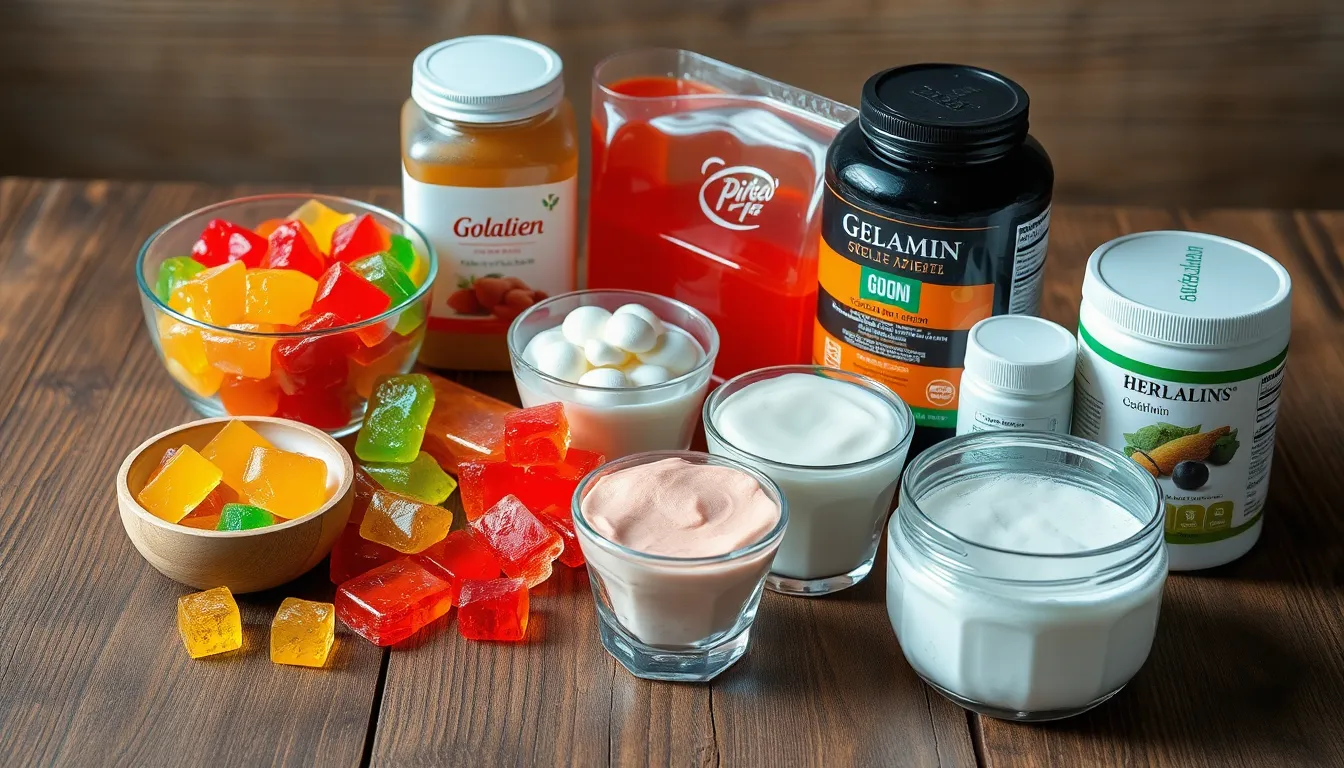Gelatin is a common ingredient found in a variety of foods and products, but its origins often spark curiosity. Many people wonder if this versatile substance is made from pork, especially those with dietary restrictions or specific lifestyles. Understanding the source of gelatin is essential for anyone who wants to make informed choices about what they consume.
Derived primarily from collagen, gelatin can come from various animal sources, including pigs, cows, and fish. While pork-derived gelatin is prevalent, it’s not the only option available. As consumers become more conscious of their food sources, it’s important to explore the different types of gelatin and how they fit into various diets. This article delves into the question of whether gelatin is made from pork and what that means for those who avoid certain animal products.
Table of Contents
ToggleUnderstanding Gelatin
Gelatin is a versatile ingredient used in diverse culinary and non-culinary applications. It’s derived from collagen, a protein found in connective tissues of animals.
What Is Gelatin?
Gelatin is a colorless, flavorless substance obtained by boiling animal skin, bones, and connective tissues. This process transforms collagen into a gel-like texture, which is widely used as a thickening agent, stabilizer, and gelling agent in products like desserts, jellies, and capsules.
Sources of Gelatin
Gelatin can originate from several animal sources. Understanding its sources aids consumers in making informed dietary choices.
| Animal Source | Description |
|---|---|
| Pork | Frequently used in commercial gelatin products; popular for its gelling properties. |
| Beef | Often used in kosher or halal products; provides similar gelling effects as pork. |
| Fish | A preferred source for those avoiding land animal products; less common but gaining popularity. |
| Chicken | Less common than other sources; used in specific culinary applications. |
Consideration of the gelatin source becomes crucial for individuals with dietary restrictions, such as vegetarians, vegans, or those observing religious practices.
Is Gelatin Made From Pork?

Gelatin can come from various animal sources, including pork. Understanding the specifics helps consumers make informed choices.
Gelatin from Animal Sources
Gelatin originates from collagen, a protein found in animal skin, bones, and connective tissues. Common sources of gelatin include:
- Pork: Derived from pig skins and bones, often utilized in candies, marshmallows, and desserts.
- Beef: Sourced from cattle bones and skins, frequently used in gummy candies and jellies.
- Fish: Extracted from fish skins and bones, suitable for kosher and halal diets.
- Chicken: Produced from chicken bones, less commonly found but sometimes used in specific products.
These animal sources affect not only the gelatin’s properties but also its suitability for various diets.
Specifics of Pork Gelatin
Pork gelatin contains distinct properties that differ from other sources. Characteristics include:
- Texture: Often produces a firmer gel compared to beef or fish gelatin.
- Flavor: Generally has no taste, suitable for various food applications.
- Usage: Commonly found in products like jelly desserts, yogurt, and certain nutritional supplements.
Pork gelatin may not meet the dietary preferences of vegetarians, vegans, or those observing specific religious restrictions, making ingredient labels essential for consumers.
Alternatives to Pork Gelatin
Various alternatives exist for those seeking to avoid pork gelatin, catering to dietary restrictions and preferences. Both plant-based and other animal-based options provide suitable substitutes for different applications.
Plant-Based Gelatin Options
Plant-based gelatin alternatives include agar-agar, carrageenan, and pectin.
- Agar-agar: Derived from red algae, it sets more firmly than traditional gelatin and is often used in desserts and jellies.
- Carrageenan: Also extracted from seaweed, carrageenan acts as a thickening and stabilizing agent in dairy products and plant-based milks.
- Pectin: Sourced from fruit, particularly apples and citrus, pectin works well in jams and jellies, giving a softer gel compared to animal-based options.
These alternatives provide various textures and flavors, appealing to vegetarians and vegans.
Other Animal-Based Gelatin
Other animal sources of gelatin include beef, fish, and chicken.
- Beef Gelatin: Sourced from cattle, beef gelatin offers a similar texture to pork gelatin and is often used in gummy candies and marshmallows.
- Fish Gelatin: Derived from fish skins and bones, fish gelatin sets similarly to pork gelatin. It’s suitable for those avoiding pork but is not vegan.
- Chicken Gelatin: Made from chicken bones and cartilage, chicken gelatin provides a milder flavor and is commonly used in soups and broths.
These alternative gelatins maintain the functional properties of traditional gelatin while catering to different dietary needs.
Health and Dietary Considerations
Understanding the health and dietary implications of gelatin consumption is vital for informed decision-making. This section highlights nutritional aspects and dietary restrictions associated with gelatin.
Nutritional Aspects of Gelatin
Gelatin contains minimal calories and no carbohydrates, making it low in energy content. One tablespoon (about 7 grams) of gelatin provides approximately 20 calories and 5 grams of protein. Gelatin contains amino acids, such as glycine and proline, which are essential for maintaining skin, hair, and joint health. Although gelatin is not a complete protein, it can supplement diets lacking in protein-rich foods. Some studies suggest that gelatin may support gut health and joint function, offering potential benefits for specific health conditions.
Dietary Restrictions
Gelatin poses challenges for various dietary restrictions due to its animal origins. Pork gelatin, specifically derived from pigs, is unsuitable for vegetarians and vegans. Additionally, individuals observing religious dietary laws, such as kosher or halal, may avoid pork-based gelatin. It’s crucial for consumers to check ingredient labels, as many products contain gelatin from diverse sources. Alternatives like agar-agar, carrageenan, and pectin provide plant-based options that cater to vegetarians and vegans while maintaining similar gelling properties. For those seeking animal-based alternatives, beef, fish, or chicken gelatin serves as viable substitutes, offering different textures and flavors for a variety of dishes.
Understanding the source of gelatin is crucial for making informed dietary choices. While pork gelatin is a common ingredient in many products it’s important to recognize the alternatives available. For those with dietary restrictions or preferences there are plant-based options like agar-agar and carrageenan as well as other animal-based gelatins from beef, fish, and chicken.
Reading ingredient labels ensures consumers can avoid unwanted sources and select products that align with their lifestyles. With a variety of options on the market everyone can enjoy the benefits of gelatin without compromising their dietary beliefs.




